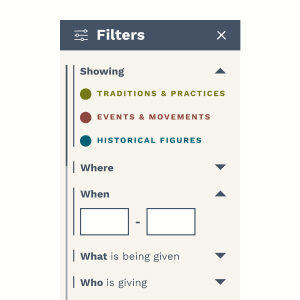Religious Giving

Credit: doidam10 via Canva.com
| Giver: | Religious Institution |
|---|---|
| Receiver: | Individual or unstructured/informal group |
| Gift: | - |
| Approach: | Other |
| Issues: | - |
| Included in: | Religious Giving |
Religious giving, a practice deeply rooted in the traditions and teachings of various faiths, has historically played and continues to play a significant role in shaping global generosity practices and philanthropy. This form of giving is often guided by religious principles and beliefs, encouraging followers to contribute to the welfare of others as an expression of their faith.
At the heart of religious giving is the concept of regard for others as a moral obligation. Major world religions, including Christianity, Islam, Judaism, Hinduism, and Buddhism, all emphasize the importance of charity and benevolence. For instance, the Christian tradition of tithing involves donating a portion of one's income to the church or to those in need, while in Islam, zakat (almsgiving) is one of the Five Pillars and is obligatory for all financially able Muslims. In Judaism, tzedakah represents the ethical obligation to do what is right and just, including charitable giving, which is considered a moral duty rather than a benevolent contribution.
This religious mandate to give has significantly influenced global philanthropy. Religious organizations and faith-based charities play a vital role in providing humanitarian aid, healthcare, education, and poverty alleviation worldwide. Their efforts are often motivated by religious teachings that emphasize compassion, service to others, and stewardship of resources.
Moreover, religious giving often extends beyond monetary donations to include volunteering, community service, and other forms of assistance. Faith communities frequently mobilize resources and volunteers to support local and international relief efforts in times of crisis or need, reflecting the communal and service-oriented aspects of religious teachings.
The impact of religious giving is also evident in the establishment and support of various institutions. Many hospitals, schools, universities, and social service organizations have been founded and sustained by religious groups, highlighting the significant role of faith in shaping educational and healthcare landscapes.
However, religious giving is not without its complexities. The intersection of religion, philanthropy, and societal needs can sometimes lead to tensions, particularly when religious beliefs influence the types of causes or groups that are supported or excluded. Additionally, the changing religious landscape, characterized by a rise in secularism in some regions, poses challenges to traditional models of religious giving.
Despite these challenges, religious giving remains a cornerstone of global philanthropy. Its influence extends far beyond the confines of specific religious communities, impacting broader societal norms and practices regarding generosity. As the world continues to evolve, the enduring principles of compassion, service, and stewardship that underpin religious giving are likely to remain influential in guiding and inspiring acts of generosity across diverse communities and cultures.
| Source type | Full citation | Link (DOI or URL) |
|---|


